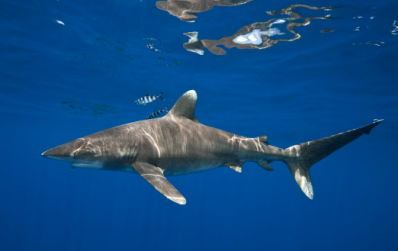Cohesive devices: oceanic whitetip shark
The Grammar Bit!
Text cohesion relates to how well a piece of writing holds together, with phrases, clauses, sentences and paragraphs threaded together in a way that makes the text easy for the reader to follow and understand.
Now that you are in Year 6, you will have had experience of using a range of cohesive devices.
With your talk partner, decide which of the following cohesive devices have been used in the text opposite:
- Use of conjunctions (but, although, because, so, while) to link words, phrases and clauses within a sentence
- Use of conjunctive adverbials (furthermore, meanwhile, on the other hand, however) to link ideas and information between sentences and paragraphs
- Use of pronouns (he, they, his, it) to refer back to a noun already mentioned or forwards to a noun not yet mentioned
- Use of a topic sentence (especially in non-fiction texts) that tells the reader what the rest of the paragraph is about
- Use of synonyms to avoid repetition
- Use of good tense consistency (the avoidance of switching tenses without good reason)
Scintillating Sentences
What do all sharks have in common?
There are 5-10 different species of shark inhabiting the world’s oceans and seas – from the mighty whale shark (reaching over 12 metres in length) to the tiny dwarf lantern shark that could sit comfortably in the palm of your hand. Despite this variety, what makes a shark a shark? What do they have in common with each other?
One of the main similarities is that all of these marine vertebrates have a skeleton made of cartilage and not bone. (This is similar to what a human’s nose and ears are made of.)
In addition, all sharks have unique skin that is covered in tiny ‘teeth’. This clever design reduces drag and enables the animals to swim faster.
Furthermore, these mainly cold-blooded creatures have gills on both sides of their head. The gills are packed with blood vessels, which absorb oxygen from the seawater.
These aren’t the only the things that the apex predators have in common, but they do illustrate their winning body design – a design that has enabled the shark family to patrol the world’s oceans and seas for millions of years.

Did you know?
Some scientists think that the white tips of the shark’s fins trick larger fish into thinking that there is a school of smaller fish swimming close to the surface at night. As the larger fish investigate, the whitetip is able to get within striking distance and grab a mouthful.

 Sign in
Sign in

